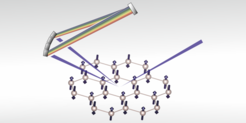Spin waves from a microcrystal
An international team of scientists from the Max Planck Institute for Solid State Research, DESY, the University of Stuttgart, Postech, and the University of Tokyo has determined the spectrum of collective magnetic excitations ("spin waves") in a ruthenium-oxide antiferromagnet, which exhibits an unusually high magnetic ordering temperature. Such measurements are important because they yield insight into the magnetic interactions between spins inside the material, but they usually require large single crystals that are difficult to synthesize. By using the newly developed IRIXS spectrometer at PETRA III, the research team was now able to obtain a complete set of measurements on a microcrystal invisible to the naked eye. The experiment demonstrates the power of the IRIXS method as a novel probe of elementary excitations in a large class of magnetic materials.

Ruthenium oxides and other 4d transition metal compounds play prominent roles in many areas of materials research ranging from oxide electronics to catalysis. Furthermore, they serve as a platform for fundamental concepts in condensed matter physics, such as unconventional superconductivity, spin liquids, and solid-state analogues of the Higgs mode in particle physics. These collective quantum phenomena emerge as a result of a delicate interplay among the Coulomb interaction between the electrons, their interaction with the crystal lattice, and the intra-atomic spin-orbit coupling. However, basic questions about the mechanisms underlying these phenomena remain unanswered, because these key parameters are comparable in magnitude and not accurately known, and because sizable single crystals required for spectroscopic experiments are often difficult to synthesize.
The research team chose the antiferromagnet SrRu2O6, where Ru spins are arranged on a two-dimensional honeycomb lattice, to demonstrate the capabilities of their new instrument. The exceptionally high Néel temperature of this compound has attracted considerable recent attention, but spectroscopic experiments have thus far not been reported because only small single crystals (50 microns in diameter) could be synthesized. The IRIXS spectrometer enabled measurements of the complete dispersion relation of spin waves, which allowed the researchers to determine the interactions between the spins and their coupling to the crystal lattice. The results, which were reported in Nature Materials, yield a complete explanation of the high magnetic ordering temperature, and they highlight the critical role of the intra-atomic spin-orbit coupling for the unconventional high-temperature antiferromagnetism of SrRu2O6. This work firmly establishes IRIXS as a versatile probe of the low-energy electronic and magnetic structure of a large variety of ruthenates and other 4d metal compounds.
The development of the IRIXS spectrometer was supported by the Advanced Grant Com4Com of the European Research Council (ERC).
More information you can find here
